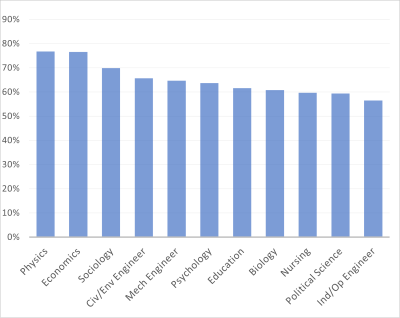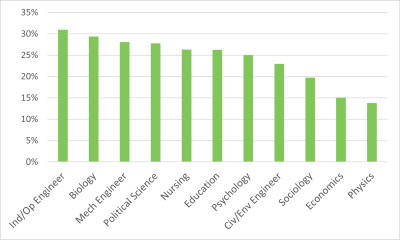|
Introduction
Most of us in English for Academic Purposes (EAP) are not subject matter experts in the disciplines our students study. With little first-hand disciplinary knowledge, how can we decide what to emphasize in teaching disciplinary writing? We can certainly ask our students about their writing needs, but EAP students often have little or no experience writing in English in their chosen discipline. We might also try collaborating with other academic departments, but this is not always feasible.
My research aims to supplement existing knowledge of disciplinary writing by analyzing the characteristics of successful student writing in various academic disciplines. Understanding verb tense/aspect (hereafter “TA”) is critical because students need to make decisions about TA in nearly every sentence, and errors in TA can obscure meaning and reduce cohesion, thereby negatively impacting evaluations of student writing (Hinkel, 2001).
Previous studies in corpus linguistics have provided a strong foundation for understanding the use of TA. An analysis of tensed verbs in published academic writing (Biber et al., 2021) found that simple (unmarked) aspect is used in more than 90% of all verb phrases, perfect aspect is more frequent than progressive aspect, and perfect progressive aspect is quite rare. A study of student placement and diagnostic essays (Hinkel, 2004) suggests that present tense is more frequent than past, and past tense is more frequent than future.
Much of the previous research on TA in student writing has been limited in scope (only one discipline or genre), level (only first-year writing), and/or size (small number of texts). Furthermore, nearly all prior studies have analyzed tense and aspect separately, without providing data on all 12 possible TA combinations (see Table 1). Future is labeled as a tense here, as is common in EAP materials, though linguists typically do not consider it a tense.
Table 1
TA combinations in English.
| |
Present tense |
Past tense |
Future tense |
|
Simple aspect |
Present
simple |
Past
simple |
Future
simple |
|
Progressive
aspect |
Present
progressive |
Past
progressive |
Future
progressive |
|
Present perfect
aspect |
Present
perfect |
Past
perfect |
Future
perfect |
|
Present
progressive
aspect |
Present perfect
progressive |
Past perfect
progressive |
Future perfect
progressive |
The Study
My research questions are as follows:
1) Which TA combinations are most frequent in successful student writing?
2) How does TA usage vary by academic discipline?
Corpus and Disciplines Used
The Michigan Corpus of Upper-Level Student Papers (MICUSP) (Römer & O’Donnell, 2011) is a great resource for students, teachers, and researchers. The corpus consists of papers written by final-year undergraduates and graduate students from years one to three, representing different academic disciplines and including both L1 and L2 English speakers. All of the papers were written for the student's credit-bearing courses, and each received an “A” grade. One could argue that getting an A is not the only marker of a successful paper, and grammatical accuracy is probably not the most important factor in determining the grade. Nonetheless, these “A” papers can serve as models of successful upper-level writing in various academic disciplines.
For this study, I limited my analysis to the 11 disciplines in MICUSP studied by at least 1% of U.S. international students, according to the U.S. Open Doors Report (Institute for International Education, 2021). These disciplines are: biology, civil and environmental engineering, economics, education, industrial and operations engineering, mechanical engineering, nursing, physics, political science, psychology, and sociology. This results in a total of 544 papers and 1,495,645 words.
Corpus Searches
I tagged the corpus with CLAWS7, a program that automatically labels the part of speech for each word. Once all of the texts had been tagged, I loaded them into Sketch Engine, a powerful corpus analysis tool known for its word sketch and advanced search features. I used Sketch Engine’s Corpus Query Language (CQL) concordance function to write searches for each of the 12 TA combinations. Table 2 gives an example of the search for future progressive, with a gloss to explain each item.
Table 2
CQL search for future progressive
|
Search |
[word="will"] |
[ ] {0,2} |
[tag="VBI"] |
[tag="VBG|VDG|
VHG|VVG"] |
|
Gloss |
will |
0, 1, or 2 words |
be (infinitive) |
being, doing,
having, verb-ing |
Tagging the data and writing CQL searches permits analysis of large datasets with a high degree of accuracy (88% of search results were accurate, and only 3% of TA combinations were not picked up by searches and, therefore, not counted).
Findings
The goal of this research was to determine the most frequent TA combinations in successful student writing and to explore how this usage varies in different disciplines. The results of the analyses are as follows:
1. Present simple is by far the most frequent TA combination, followed by past simple, present perfect, future simple, and present progressive.
The seven other TA combinations are used in less than 1% of all tensed verb phrases, as seen in Table 3. TA combinations that incorporate future tense and/or perfect progressive aspect are among the least frequent choices. There are no instances of future perfect progressive in the corpus.
Table 3
Frequency and percentage of use for TA combinations totaled across all 11 disciplines.
|
TA combination |
Frequency |
Percentage |
|
present simple |
73,187 |
63.70% |
|
past simple |
28,816 |
25.08% |
|
present perfect |
5,180 |
4.51% |
|
future simple |
4,634 |
4.03% |
|
present progressive |
1,592 |
1.39% |
|
past perfect |
782 |
0.68% |
|
past progressive |
523 |
0.46% |
|
present perfect progressive |
85 |
0.07% |
|
future progressive |
54 |
0.05% |
|
past perfect progressive |
32 |
0.03% |
|
future perfect |
14 |
0.01% |
|
future perfect progressive |
0 |
0.00% |
|
Total |
114,899 |
|
2. The rates of use for TA combinations are different in student writing from specific academic disciplines.
When the corpus is divided into disciplinary subcorpora, the differences in TA use become apparent. These differences can be illustrated by looking at the rates of use for the two most frequent TA combinations, present simple and past simple.
Figure 1 shows the percentage of tensed verbs in present simple for each discipline. Physics, economics, and sociology have the highest rates of use; nursing, political science, and industrial/operations engineering have the lowest.
Figure 1. Rates of use for simple present in each of the 11 disciplines.

Figure 2 shows the percentage of tensed verbs in past simple for each discipline. Industrial/operations engineering, biology, and mechanical engineering have the highest rates of use; sociology, economics, and physics have the lowest.
Figure 2. Rates of use for simple past in each of the 11 disciplines.

3. Despite these differences, the most frequent TA combinations in student writing are quite consistent across all 11 disciplines.
As can be seen in Table 4, present simple was the most frequent TA combination in all disciplines, followed by past simple. Present perfect and future simple ranked either third or fourth, and present progressive was ranked fifth in every discipline.
Table 4
Ranking of TA combinations by frequency in each discipline.
|
TA |
BIO |
CEE |
ECO |
EDU |
IOE |
MEC |
NUR |
PHY |
POL |
PSY |
SOC |
|
present
simple |
1 |
1 |
1 |
1 |
1 |
1 |
1 |
1 |
1 |
1 |
1 |
|
past
simple |
2 |
2 |
2 |
2 |
2 |
2 |
2 |
2 |
2 |
2 |
2 |
|
present
perfect |
3 |
3 |
4 |
4 |
4 |
4 |
4 |
3 |
3 |
3 |
3 |
|
future
simple |
4 |
4 |
3 |
3 |
3 |
3 |
3 |
4 |
4 |
4 |
4 |
|
present
progressive |
5 |
5 |
5 |
5 |
5 |
5 |
5 |
5 |
5 |
5 |
5 |
These findings indicate that some TA combinations are much more frequent than others in successful student writing. In fact, some are hardly used at all. While there are noticeable differences between the actual rates of use in different disciplines, the overall frequency rankings for TA combinations by discipline are very similar.
Reflection & Discussion
Although I already knew that some TA combinations were more commonly used than others, the degree to which they differ was still quite striking. From personal experience writing a chapter on future perfect for a grammar textbook, I had to write far more future perfect sentences in a single chapter than occurred in this study's entire corpus of 544 papers.
How much should frequency data, like the results presented in this study, factor into pedagogical decisions? Arguably, frequency data can be very valuable. Focusing on less frequent items, like future perfect, may waste valuable instructional time on grammatical structures that students are unlikely to use or need. On the other hand, frequency should not be the only consideration when it comes to curriculum and materials design. Some low-frequency structures may be interesting, challenging, and/or especially relevant for a particular class, and therefore worth including.
This study has aimed to inform the teaching of tense and aspect in EAP. With these results in mind, instructors can take students’ academic disciplines into account and focus on the most common TA combinations in successful student writing from those disciplines. In the absence of data for a particular discipline, the findings from the corpus as a whole may serve as a guide. For the reasons mentioned above, I would not advocate that we stop teaching the less frequent TA combinations altogether. However, we may first want to consider whether our students would be better served by directing their attention to more frequent grammatical items.
References
Biber, D., Johansson, S., Leech, G. N., Conrad, S., & Finegan, E. (2021). Grammar of spoken and written English. John Benjamins. https://doi.org/10.1075/z.232
Hinkel, E. (2001). Teaching grammar in writing classes: Tenses and cohesion. In S. Fotos & E. Hinkel (Eds.), New perspectives on grammar teaching in second language classrooms (pp. 183–199). Taylor & Francis. https://doi.org/10.4324/9781410605030
Hinkel, E. (2004). Tense, aspect and the passive voice in L1 and L2 academic texts. Language Teaching Research, 8(1), 5–29. https://doi.org/10.1191/1362168804lr132oa
Institute for International Education. (2021). IIE open doors 2021: Fields of study. https://opendoorsdata.org/data/international-students/fields-of-study/
Römer, U., & O’Donnell, M. B. (2011). From student hard drive to web corpus (part 1): The design, compilation and genre classification of the Michigan Corpus of Upper-level Student Papers (MICUSP). Corpora, 6(2), 159–177. https://doi.org/10.3366/cor.2011.0011
Lily Lewis is a postgraduate researcher at the University of Birmingham and a Writing Instructor at National Defense University. Her research interests include academic writing, EAP, and corpus linguistics. |

